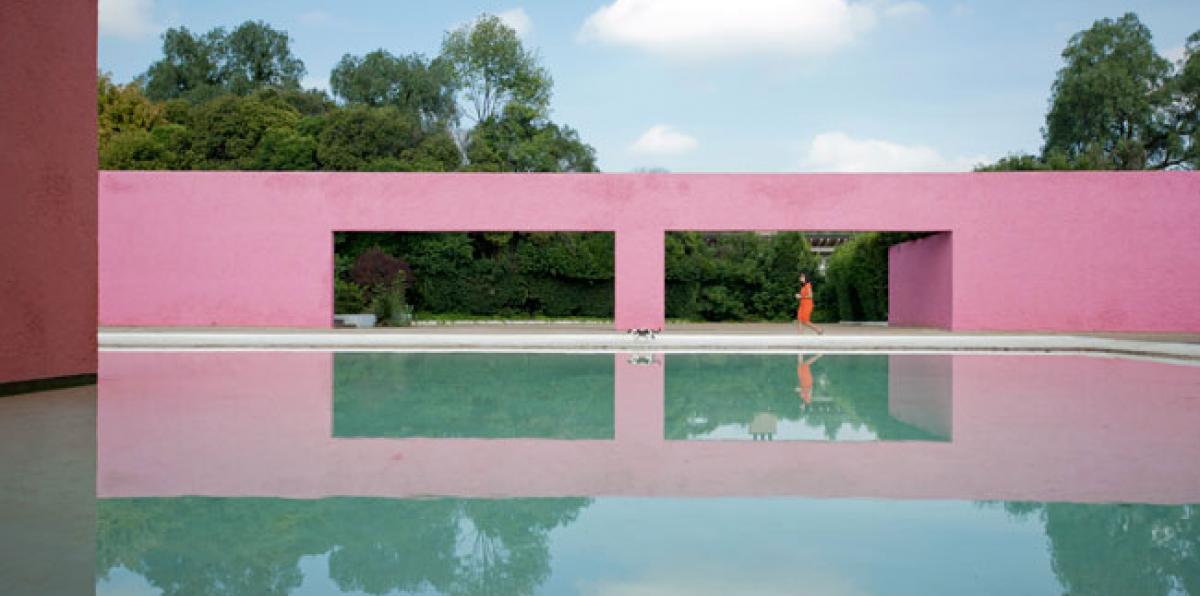THE DOGRUN
a place to share ideas


Travel Stories: Mexico City Day 2.2 Barragan
Posted by mindygudzinski on 9/27/12 at 9:47 am
A group of 6 LF’ers recently ventured down to Mexico City to enjoy the food, culture and the architecture. These are our stories in a four-part mini series.
We had a chance to visit two beautiful projects by Mexican architect Luis Barragán on our travels. The San Cristobal Stables designed in 1966 was first on our adventure. Barragán used bright colors in his architecture and became famous for his clever use
of textured monolithic walls as a backdrop for which he played with light and shadow. Beautiful caramel colored wood warms the spaces meant for human and animanl habitation and was carefully placed on surfaces associated with touch. The stables are a peaceful escape from the hustle and bustle of the endless city for both the horses and their caretakers.
 Casa Barragán was next on our must see list. Built in 1948 it is now recognized as a UNESCO World Heritage Site in Mexico. Barragán was a master of space and light as he demonstrated throughout his house and studio. Upon crossing the threshold into a room we were never permitted to fully experience a space. It was as if each room were a place of quiet theatre where the sense of mystery captured our imagination and held our attention. His play on light, materials, and compression of space guided us around walls and furniture to then experience the greater room in its entirety. It is a place where distinctions between outside and inside dissolve, gardens become rooms whose ceiling is the sky and rooms become secret gardens.
“A visitor to my house is anxious to discover where the floating staircase in the library leads or, arriving in the seemingly wild garden, to ascertain what is hidden beyond the green shrubs and hanging vines.” -Luis Barragán
Casa Barragán was next on our must see list. Built in 1948 it is now recognized as a UNESCO World Heritage Site in Mexico. Barragán was a master of space and light as he demonstrated throughout his house and studio. Upon crossing the threshold into a room we were never permitted to fully experience a space. It was as if each room were a place of quiet theatre where the sense of mystery captured our imagination and held our attention. His play on light, materials, and compression of space guided us around walls and furniture to then experience the greater room in its entirety. It is a place where distinctions between outside and inside dissolve, gardens become rooms whose ceiling is the sky and rooms become secret gardens.
“A visitor to my house is anxious to discover where the floating staircase in the library leads or, arriving in the seemingly wild garden, to ascertain what is hidden beyond the green shrubs and hanging vines.” -Luis Barragán
 Unfortunately photos were not allowed of the interior of the house but the architectural lessons learned by experiencing the spaces Barragán created were beyond inspiring and will forever be engrained in our memories.
Next: Mexico City Day 3.1 Teotihuacán
Unfortunately photos were not allowed of the interior of the house but the architectural lessons learned by experiencing the spaces Barragán created were beyond inspiring and will forever be engrained in our memories.
Next: Mexico City Day 3.1 Teotihuacán
 Casa Barragán was next on our must see list. Built in 1948 it is now recognized as a UNESCO World Heritage Site in Mexico. Barragán was a master of space and light as he demonstrated throughout his house and studio. Upon crossing the threshold into a room we were never permitted to fully experience a space. It was as if each room were a place of quiet theatre where the sense of mystery captured our imagination and held our attention. His play on light, materials, and compression of space guided us around walls and furniture to then experience the greater room in its entirety. It is a place where distinctions between outside and inside dissolve, gardens become rooms whose ceiling is the sky and rooms become secret gardens.
“A visitor to my house is anxious to discover where the floating staircase in the library leads or, arriving in the seemingly wild garden, to ascertain what is hidden beyond the green shrubs and hanging vines.” -Luis Barragán
Casa Barragán was next on our must see list. Built in 1948 it is now recognized as a UNESCO World Heritage Site in Mexico. Barragán was a master of space and light as he demonstrated throughout his house and studio. Upon crossing the threshold into a room we were never permitted to fully experience a space. It was as if each room were a place of quiet theatre where the sense of mystery captured our imagination and held our attention. His play on light, materials, and compression of space guided us around walls and furniture to then experience the greater room in its entirety. It is a place where distinctions between outside and inside dissolve, gardens become rooms whose ceiling is the sky and rooms become secret gardens.
“A visitor to my house is anxious to discover where the floating staircase in the library leads or, arriving in the seemingly wild garden, to ascertain what is hidden beyond the green shrubs and hanging vines.” -Luis Barragán
 Unfortunately photos were not allowed of the interior of the house but the architectural lessons learned by experiencing the spaces Barragán created were beyond inspiring and will forever be engrained in our memories.
Next: Mexico City Day 3.1 Teotihuacán
Unfortunately photos were not allowed of the interior of the house but the architectural lessons learned by experiencing the spaces Barragán created were beyond inspiring and will forever be engrained in our memories.
Next: Mexico City Day 3.1 Teotihuacán